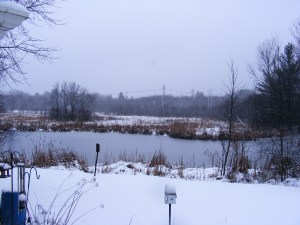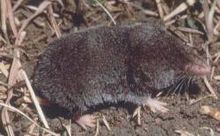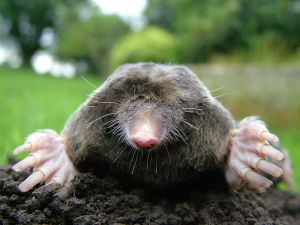At least we can say the March came in like a lion… However, I am still finding it very hard to believe that the worst of our New England winter is over. I know what you are going to say, “What winter?” In my lifetime I cannot remember having this little snow and such warm sunny days. The lack of snow this winter, however, has definitely put a crimp in my winter tracking activities. It has also provided a little bit more of a challenge, and well, challenge can be fun! That said I am looking forward to some winter tracking this weekend!

A couple of weeks ago I went on a “varmint” hunt. Given the lack of snow and some spring “melt,” if you can call it that, I figured I had a fairly good chance of finding sign of some ground-burrowing critters. I started by looking under hanging garden plants and turning over boards or other fixed objects in our back yard. Bingo!
What did I find? Shrews! Shrews have been called a lot of things but I think that Sudbury Valley Trustees described them best as “tiny tigers.” They have sharp, spike-like teeth and as the smallest mammal no bigger than our thumb (2 to 4 inches), these creatures spend most of their time running around in above-surface tunnels hunting a variety of bugs and earthworms. They will also eat other shrews, mice, salamanders, snakes and have even been known to kill small rabbits! They may also eat mast, seeds or eggs. Shrews will even cover their “kill” with grass or leaves for a later meal (just like my cats try to do with their food bowls). The shrew does not have grinding teeth and the tips of their teeth have a yellowish color when living, at least in New England.


Their size often allows them to escape our attention even though they are fairly common. They, like other ground-dwelling varmints such as mice, voles and moles are considerably active throughout the winter.

How do you know if you have shrews, rather than one of the other rodents? That is, other than seeing them. Shrews, being the smallest mammal also make the smallest hole (1 inch or less). They do not make meandering ridges just under the surface of the ground under snow like voles or moles or create 6 inch round entrance mounds like moles. If I were to catch one, I would find that each front foot of a shrew has 5 toes, where a mouse would only have 4 front toes.

Behaviorally, shrews and voles are much alike. They both make tunnels or pathways in the grass and these runways can be difficult to discern from each other, especially since they will use another animals’ highway complex.

The difference is often the size. Shrew pathways which can be located in grass or leaf litter are usually less than an inch in diameter, whereas vole tunnels are slightly larger and usually only in grass. They also landscape their tunnels differently. Voles nip or cut the vegetation on the sides and bottom of their tunnels, sometimes leaving only bare earth. Shrews are less fastidious and the grass will often just be plowed to the side.
Interestingly, shrews are known to have a putrid, musky odor that makes them unpalatable to predators, so usually the only time they are found is after they have met their fate and been abandoned. BTW this is how I knew I had a good chance of finding them in my back yard… Either the fox or a neighborhood cat had clued me in. It is generally believed that the odor is a reproductive marker as it appears stronger during mating. Some shrews that we will find here in Massachusetts include the short-tailed shrew (Blarina brevicauda), least shrew (Cryptotis parva) and the masked shrew (Sorex cinereus).
Shrews are unusual among mammals in a number of respects. They are one of only two land mammals known to echolocate (the other is a mammal from Madagascar that resembles a hedgehog). Unlike most mammals, however, some species of shrew are venomous. Shrew venom is not conducted into the wound by fangs, but by grooves in the teeth. The venom contains various compounds, and the contents of the venom glands of the American short-tailed shrew are sufficient to kill 200 mice if delivered by intravenous injection. Don’t worry though, it won’t kill a human, but it may cause some swelling. Always best not to handle a live shrew without some protection. Just in case you were thinking about going homicidal on your backyard shrews, think again. Like every other living thing on the planet there is always hidden utility. Shrew venom has potential medical use, as one chemical extracted from shrew venom has been demonstrated to show potential for the treatment of blood pressure. Another compound may be useful in the treatment of some neuromuscular diseases and migraines. The saliva of the Northern Short-tailed Shrew (Blarina brevicauda) contains the peptide soricidin and has accordingly been studied for use in treating ovarian cancer. Another interesting factoid…Amazingly, shrews hold nearly 10% of their mass in their brain, which is the highest brain to body mass ratio of all animals (humans included!)

Now moles,on the other hand, are just plain funky! The most common foods moles eat include earthworms, insect larva and other soil arthropods. They also eat grubs and plant bulbs but not as voraciously as the vole does. Most mole damage is caused by tunneling in our monotypic lawn, and not by eating plants. Go Moles!!! The most commonly encountered moles are the eastern mole, which causes most of the damage found in yards, and the star-nosed mole, which is mostly found digging tunnels in swampy areas and at deeper levels than the eastern mole. Mole feeding tunnels are usually 2 to 3 inches below the surface.

Okay, right about now you are thinking that I am absolutely insane because I am happy that I have rodents! Probably true. If they were in my house I would be at Agway right now looking at all kinds of unique ways to remove them from my abode. But what their presence in my yard, and especially in my garden, tells me is that my organic gardening practices are working. I attempt to provide a variety of plants for a variety of native insects. I do not use chemicals or fertilizer formulations other than compost tea or a nature-based organic nutrient source. I leave my leaves and plant structure throughout the winter to provide overwintering area and a food source for the critters. The presence of the shrew means that my garden is beginning to function as a miniature ecosystem with a natural balance of both predator and prey, which on a cold snowy day makes me smile.

